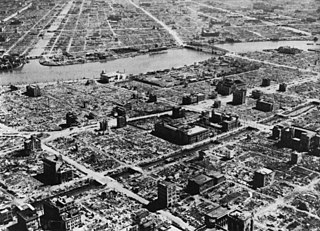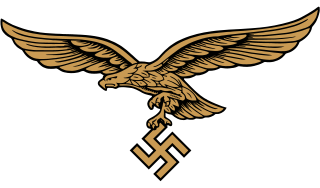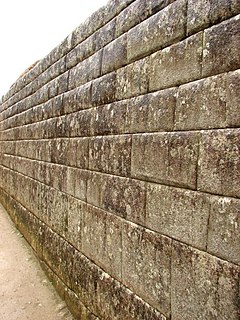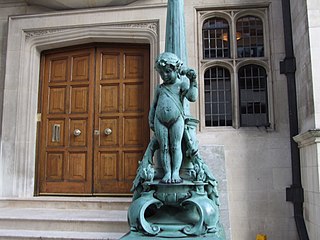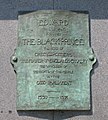
Yeadon is a town within the metropolitan borough of the City of Leeds, West Yorkshire, England.

Adel is a suburb in North Leeds, West Yorkshire, England. It is situated between Cookridge, Holt Park, Weetwood and Alwoodley. To the north are the villages of Arthington and Bramhope and the market town of Otley.

Albert Square is a public square in the centre of Manchester, England. It is dominated by its largest building, the Grade I listed Manchester Town Hall, a Victorian Gothic building by Alfred Waterhouse. Other smaller buildings from the same period surround it, many of which are listed.
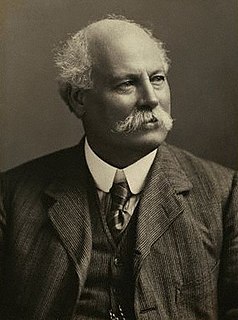
Sir Thomas Brock was an English sculptor, and medallist, whose works include the monument to Queen Victoria in front of Buckingham Palace.

Millennium Square is a large city square in the Civic Quarter of Leeds, West Yorkshire, England. It was Leeds' flagship project to mark the year 2000, and was jointly funded by Leeds City Council and the Millennium Commission. Total cost of production was £12 million.

Leeds Civic Hall is a municipal building located in the civic quarter of Leeds, West Yorkshire, England. It replaced Leeds Town Hall as the administrative centre in 1933. The Civic Hall houses Leeds City Council offices, council chamber and a banqueting hall, and is a Grade II* listed building. A city landmark, two 2.3 metres high gold-leafed owls top its twin towers, decorations which are joined by four more owls on columns in Millennium Square, which sits to the front, and a gilded clock on both sides.

Leeds General Infirmary, also known as the LGI, is a large teaching hospital based in the centre of Leeds, West Yorkshire, England, and is part of the Leeds Teaching Hospitals NHS Trust. Its previous name The General Infirmary at Leeds is still sometimes used. It is the second largest hospital in Leeds after St James's University Hospital.

Trinity Leeds is a shopping and leisure centre in the Victorian District of Leeds, England, named after the adjacent 18th-century Holy Trinity Church. It opened on 21 March 2013, with over 130,000 recorded visitors on opening day. The development is in two parts: Trinity East, a new build development on the site of the former Trinity and Burton Arcades, and Trinity West, the redeveloped Leeds Shopping Plaza. The development has a catchment of 5.5 million people offering a spend of £1.93 billion annually. It has lifted Leeds from seventh to fourth in the CACI UK retail rankings and has created over 3000 jobs.
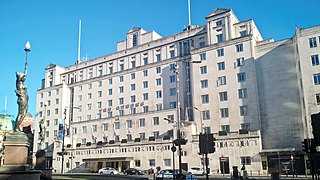
The Queens Hotel is a hotel owned by QHotels, located on Leeds City Square in Leeds, West Yorkshire, England. It is an elegant Art Deco Grade II listed building.
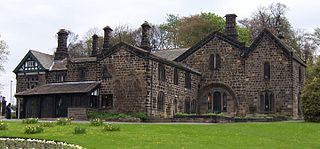
Abbey House Museum in Kirkstall, Leeds, West Yorkshire, England is housed in the gatehouse of the ruined 12th-century Kirkstall Abbey, and is a Grade II* listed building. The house is 3 miles (4.8 km) north west of Leeds city centre on the A65 road.

Leeds Art Gallery in Leeds, West Yorkshire, England, is a museum whose collection of 20th-century British Art was designated by the British government in 1997 as a collection "of national importance". Its collection also includes 19th-century and earlier art works. It is a grade II listed building owned and administered by Leeds City Council, linked on the West to Leeds Central Library and on the East via a bridge to the Henry Moore Institute with which it shares some sculptures. A Henry Moore sculpture, Reclining Woman: Elbow (1981), stands in front of the entrance. The entrance hall contains Leeds' oldest civic sculpture, a 1712 marble statue of Queen Anne.

(Edward) Alfred Briscoe Drury was an English architectural sculptor and figure in the New Sculpture movement. Drury is best represented at the Victoria and Albert Museum, where he contributed the figure of Prince Albert immediately above the main entrance, nine lunettes with Drury's characteristic allegorical girls each bearing a portion of the museum's motto, allegorical figures of Inspiration and Knowledge, and Queen Victoria above it all, carrying a staff and flanked by a knight and angel.
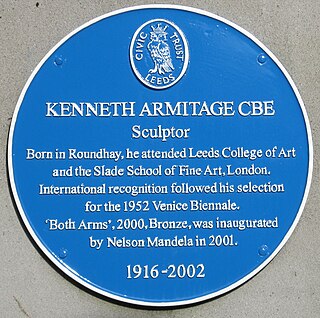
William Kenneth Armitage was a British sculptor known for his semi-abstract bronzes.

Park Square is a Georgian public square in central Leeds, West Yorkshire. The square is grassed over and is a traditional Georgian park. The square is in Leeds' financial quarter and is surrounded by Georgian buildings, which are occupied as offices, many by barristers and solicitors.
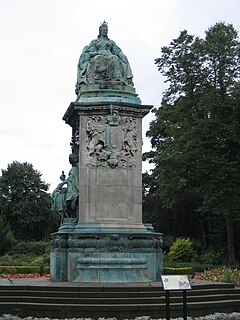
A Memorial to Queen Victoria stands in Woodhouse Moor, Leeds, West Yorkshire, England.

William Mawson was an English architect best known for his work in and around Bradford.

The equestrian statue of William III by John Bacon Junior stands in St James's Square in central London. It is modelled on an earlier statue of the king by John Michael Rysbrack in Queen Square, Bristol. Funding for the London statue was provided in the will of Samuel Travers, M.P., dated 1724, but nothing was done to progress the plan for a further seventy years. A design for the monument was drawn up in 1794 by Bacon's father, John Bacon Senior, but this was not executed and the commission passed to Bacon Jr., under whose direction the statue was finally erected in 1808. The statue is a Grade I listed structure.
Mawer and Ingle was a company of architectural sculptors, based in Leeds, West Yorkshire, England, between 1860 and 1871. It comprised cousins Charles Mawer and William Ingle (1828–1870), and Catherine Mawer (1804–1877) who was mother of Charles and aunt of William. The group produced carvings on many Gothic Revival churches and their internal furnishings. They also worked on civic buildings, warehouses and offices. Many of these are now listed by Historic England, and many of the surviving buildings are within Yorkshire. Their work outside Yorkshire included Trent Bridge.






